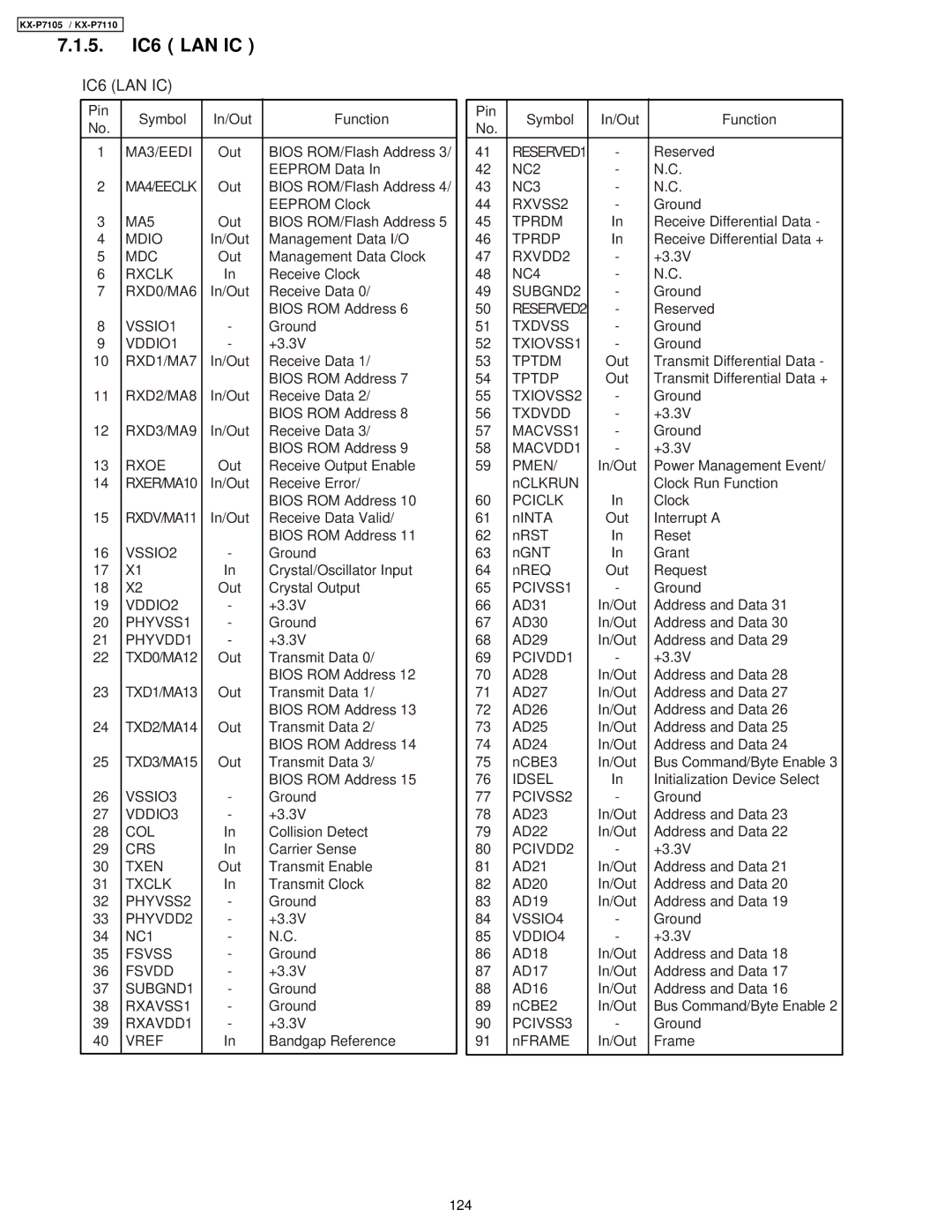KX-P7105 KX-P7110
KX-P7105 / KX-P7110
Contents
KX-P7105 / KX-P7110
Specifications
Printer
Paper
Interface, Options, Accessories, and Supplies
Others About Media
Margins and Print Area
Indicators
Printer Panel Indicators
Print / Reset Button
Parts Identification
Front Side View Rear Side View
Component Layout and Paper Path
Electrical Components and Sensor Boards
Switches and Solenoids
Development / Cleaning
Print Process
Charge
Exposure
Fusing
Transfer
Paper Feed
Media Tray
Operation Theory
Laser Scan Unit Exposure
Laser Beam
Collimator Lens
Polygon Scanner
Cylindrical Lens and Lens
Lens
Fuser Unit
Paper Ejection and Paper Switchback
Normal Printing Mode Not Duplex Mode
Installation Requirements
Setup
KX-P7105 / KX-P7110
Installing the Upgrade Kit for PostScript or RAM Board
Repacking
Material Required
KX-P7105 / KX-P7110
KX-P7105 / KX-P7110
Removal and Replacement Procedures
Front and Rear Covers
Front Cover Disassembly
Rear Cover Disassembly
Right, Left and Top Covers
Right Cover
Left Cover
Top Cover
Laser Scanning Unit LSU
Relay Board B
High Voltage Board and Power Supply Unit
High Voltage Board
Power Supply Unit
Power Supply Unit Disassembly
Engine Control Board and Toner Empty Sensor Board
Indicator Board
Engine Control Board
Toner Empty Sensor Board
Nd Feeder I / F Board and Main Control Board
Nd Feeder I / F Board and Main Control Board
Fuser Drive Gear
Main Control Board Disassembly
Fan Motor
Gear Support Bracket
Relay Board a , Drive Gear Unit and Motor
Drive Gear Unit Disassembly
Paper Empty Sensor Board
Upper Exit Roller Holder
Upper Exit Roller Holder Disassembly
Upper Exit Roller Holder
Fuser Unit Disassembly
Heat Lamp
Heat Roller
Thermostat
KX-P7105 / KX-P7110
Pickup, Paper Feed, Registration and Transfer Rollers
Pickup Roller and Pickup Solenoid
Paper Feed Roller / Registration Roller
Registration Roller
Transfer Roller Assembly
Auto Duplex Unit ADU
Auto Duplex Pinch and Registration Rollers
Auto Duplex Disassembly
KX-P7105 / KX-P7110
KX-P7105 / KX-P7110
Paper Empty Sensor Lever
Block Diagram
Main Control Board Block Diagram
Engine Control Block Diagram
Fuser Unit
Connection Diagram
Connection Diagram
Power Supply
Engine Control Board
Asic KME
Reset Circuit
Clock Circuit
Main Motor Drive Circuit
Motor Current will be cut off in case of OFF condition above
Laser Scanning Unit Control Circuit
Fuser Temperature Control Circuit
High Voltage Control Circuit
Eeprom Control Circuit
Safety Interlock SW
Pickup Control Solenoid Drive Circuit
Solenoids Control Circuit
Registration Solenoid Driver Circuit
Switchback Solenoid Drive Control Circuit
Registration Sensor Circuit
Sensors Circuit
Top Sensor Circuit
Exit Sensor Circuit
Paper Empty Sensor Circuit
Toner Empty Sensor Circuit
Fan Control Circuit
2nd Feeder control signals are explained as follows
Nd Feeder I / F Circuit
KX-P7105 / KX-P7110
Main Control Board
Data Flow
Power Supply
Clock Circuit
CPU Asic IC1 overview
CPU
Sdram I/F
Sdras
ROM I/F
FRCS1
Eepdata
Internal Engine I/F Main Board Engine Board
SXD
Operation Panel Circuit
Parallel I/F
USB I/F
PCI I/F
Pcitrdy
Network I/F only for KX-P7110
TPRDM, Tprdp
KX-P7105 / KX-P7110
Main Control Board
Option ROM CN
Option RAM CN
Main Control Board 4/9
IEEE1284 Circuit Block
Main Control Board 6/9
ICE Connector
Power Regulator Circuit
Main Control Board
KX-P7105 / KX-P7110
Engine Control Board
Engine Control Board 2/3
Parts Side
102
Sensors, Indicator and Relay Boards
104
Paper Empty Sensor Board, 2nd Feeder I/F Board
106
Explanation of Connectors
1. CN1 Optional PostScript Upgrade Kit I / F Connector
CN2 Optional RAM Connector
2. CN2 Optional RAM Connector
3. CN3 Network Connector
CN2
CN4 Ieee 1284 I/F Connector
4. CN4 Ieee 1284 I / F Connector
5. CN5 Engine I / F Connector
6. CN6 Front Panel Connector
7. CN9 USB I / F Connector
1. CN001 Video Interface
3. CN003 OPC Drum Unit Interlock SW
2. CN002 LSU Control Signals
4. CN004 2nd Feeder
5. CN005 PSU-MAIN Connector
8. CN008 HVU-MAIN Connector
6. CN006 Door + 24V Interlock SW
7. CN007 Thermistor
CN013 Switchback Solenoid
9. CN009 Toner Empty Sensor
CN010 Polygon Motor
CN011 Pickup Solenoid
14. CN014 REG-TOP Sensor
CN015 Exit Sensor
CN017 Main Motor
CN018 FAN Control
Registration & Paper Top Sensor Board
Paper Exit / ADU Paper Jam Sensor Board
Paper Empty Sensor Board
Toner Empty Sensor Board
1. CN407 Fuser GND
1. CN450 Paper Empty Sensor
1. CN452 to Engine Control Board CN004
Nd Feeder I / F Board
2. CN453 to 2nd Feeder
Component Reference Guide
1. IC1 Main Control CPU
IC1
2. IC2 Reset IC
GND12
3. IC3 Flash / Mask ROM
4. IC5 RAM
5. IC6 LAN IC
IC6 LAN IC
6. IC7 Eeprom
7. IC10 Regulator
8. IC12 Regulator
1. IC001 Asic
3. IC003 Reset IC
2. IC002 Comparators
4. IC004 Engine Control CPU
5. IC005 Eeprom
6. IC006 Motor Drive IC
7. IC007 Inverters
General
Recommended Cleaning
Recommended Tools
Maintenance Tables
User Maintenance
Service Maintenance Maintenance Cycle
Counter Reset
Lubrication
Recommended Lubrication
Self-Diagnostic Indicators
Printer Status Paper Jam
User Error
Call for Service
Initial Troubleshooting Flowchart
No Operation
Print Quality
White Vertical Line in Print
Blank Print
Dark Vertical Line in Print
Dark Horizontal Line in Print
Dirty Background
All-black Print
Light Print
Ghosting
Black or White Dots
Toner Spatter
Paper Jam
Jam at a
Jam at B
Jam at C
Jam at D, E
Jam at STD
Jam at OP
Call Service
1. E20
156
2. E30
3. E31
4. E32
5. E50
6. E54 7. E71
8. E73
9. E81
10. E90
11. E91
12. E96
Replacement Parts List with Lubrication Guide
Exterior
168
Right Side Parts
169
170
Engine Control Board Connector
Pickup Roller and Paper Feed Roller
Motor and Drive Gear Unit
Left Side Parts Power Supply Unit and High Voltage Board
Rear and Top Side Parts
Fuser Unit
176
177
Bottom Side Parts
178
179
Mechanical Base
Media Tray Paper Cassette
Packing
Component Side View
Parts Side View
Capacitors
ICs
Resistors
Transistor and Diodes
10.9.5 Connectors
10.9.6 Others
188
189
190
191
Registration & Paper Top Detection Sensor Board
Resistor values is in OHMs
Relay Board a
Resistor values are in OHMs
194
